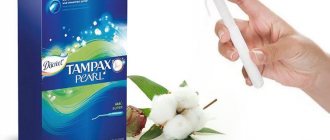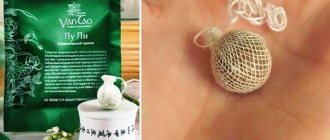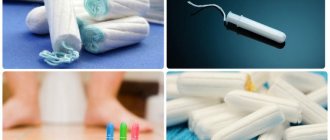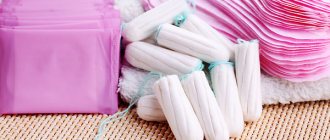Hygienic tampons
Tampon (gynecological tampon)
- an intimate hygiene product, which is a small cylinder made of cotton wool, soft matter, modern absorbent soft materials, inserted by a woman into the vagina during menstruation.
The purpose of the inserted tampon is to absorb menstrual blood and other secretions, preventing them from getting on the woman’s clothes. Tampons are a convenient thing that makes a woman’s life much more comfortable during her period.
What scares women about tampons or what myths exist about this product?
The main source of horror stories about the use of tampons are women's forums, where you can read the most unimaginable versions:
- when inserting a tampon, a woman may faint, and virgins may generally lose their innocence because of this product;
- the use of tampons by young girls can cause masturbation and depravity;
- men are disgusted with women who use this hygiene product;
- A tampon is an ideal tool for preventing pregnancy.
More advanced tampon haters make medical arguments, claiming that:
- erosion, inflammatory processes of the pelvic organs, endometriosis - all these are consequences of the use of tampons;
- this hygiene product is saturated with dangerous chemicals that negatively affect the mucous membrane, corroding it;
- a tampon is a kind of plug that closes the vagina and acts as a barrier to the outflow of blood;
- the use of this remedy increases the likelihood of sexually transmitted diseases and can cause problems with conception.
What is most interesting is that most of these statements are ridiculous due to their ignorance. Let's figure out what tampons are, what the dangers of using them are, and how to prevent possible complications.
What are the true facts about tampons?
Due to the fact that many consider tampons to be potentially dangerous, many studies have been conducted by manufacturers, independent firms, and certification bodies. As a result, it was proven that if tampons are used correctly, then:
- tampons do not interfere with the flow of menstrual blood and do not form a plug. When the tampon is soaked, the blood passes through it and flows out effortlessly;
- tampons do not provoke changes in vaginal flora and the proliferation of bacteria. The vaginal environment changes due to menstruation, not because a tampon is inserted;
- these hygiene products do not cause rupture of the hymen - the hole for blood to escape in it is about 1.5 cm, and the hymen is very elastic during menstruation. By absorbing moisture, the tampon only increases in length and, when removed, cannot harm the young girl;
- tampons do not cause the development of bad sexual habits. If it is introduced correctly, then the woman practically does not feel it; in other words, this remedy does not provoke any pleasant sensations;
Fact. Tampons do not cause the development of dangerous diseases and cannot affect the duration of menstruation, since the vagina easily adapts to the size of the tampon and does not come into contact with the uterus, which is perfectly protected. And the duration of menstruation and its intensity depends on physiology, hormone levels, physique, weight and other internal factors.
- tampons cannot end up in the uterus, get stuck in the vagina, or get lost, as many people fear. With muscle activity, even a tampon inserted too deeply will easily come out on its own. There are also concerns that the string on the tampon may come off. However, this is almost impossible, since this rope can withstand a load of about five kilograms. In addition, it is securely sewn along the entire length of the tampon.
Tampons and Pads: Frequently Asked Questions
Tampons and Pads: Frequently Asked Questions
How long ago did hygiene products such as tampons and pads appear?
These funds appeared in Europe and the USA about 70 years ago. But if we turn to ancient history, we will understand that analogues of modern tampons and pads have always existed.
Egyptian women used soft papyrus during menstruation. It was rolled up into a tube and inserted into the vagina. For this purpose, the Romans made rolls of wool and greased them with fat so that they could be inserted better. On the African continent, the soft parts of young bamboo were popular. Representatives of northern peoples also used improvised material: moss - reindeer moss - acted as gaskets. The ancient Slavs did not find use for tampons. They made pads from cloth and tied these “structures” to their belts - underwear did not exist at that time. But long, loose skirts hid an unaesthetic sight. The researchers concluded: in countries where women led an active lifestyle - they used to ride horses, for example - tampons were used. Where the ladies were more sedate were sanitary pads.
Who invented the modern tampon?
The first modern vaginal tampon was created by the American surgeon Eol Haase. This was done at the urgent request of his wife in 1933. During the First World War, she was at the front, she herself experienced all the hardships of life in the field and, wanting to alleviate the lot of women, she invited her husband, Dr. Haase, to “design” and start producing tampons.
If you add up all the menstrual days a woman has, the total is 7 years! For 7 years of her life she is doomed to feel uncomfortable and give up some of her usual activities. The external pads that women used in these cases are inconvenient, they must be changed frequently and are difficult to destroy, they do not allow free movement, exercise, swimming, dancing; irritate the skin in hot weather; the unpleasant odor that menstrual blood acquires when interacting with air also confuses a woman. Tampons are free of these disadvantages; since their invention, all women have become freer.
Is it dangerous to use tampons?
Completely safe. If you don’t have the skill, it’s better to first use tampons with an applicator. If you feel a little discomfort, it means you simply did not insert it deeply enough. In this case, the tampon should be replaced with a new one.
Use tampons only during menstruation. By absorbing menstrual blood, the tampon does not allow it to flow out, while it lengthens and expands, taking the shape of the vagina and you do not feel its presence. The tampon absorbs menstrual fluid until it is completely saturated, and then begins to leak—to let the discharge through, with all the unpleasant consequences. Worried about their daughters, mothers often ask: can a tampon damage the hymen? No, it is elastic enough, and the hole in the hymen through which the blood flows out is wide enough to allow a tampon to be carefully inserted into the vagina.
How to insert a tampon correctly?
In order to insert a tampon, you need to carefully understand and concentrate only for the first time. Then, when it becomes a habit, using tampons will be very easy. You will find detailed instructions on how to insert a tampon correctly in the instructions included in each package. It must be removed at the same angle at which it was inserted by pulling the pull cord. The pull cord is very durable and cannot break, as it can withstand loads of up to 5 kg and is stitched along the entire length of the tampon.
Can a tampon get “lost” inside or fall out?
The tampon cannot fall out; the vaginal muscles hold it firmly. It cannot go inside either; the opening of the cervix is too small for this.
How often should you change tampons?
You need to change tampons every 4-6 hours or, depending on the amount of menstruation, a little less often - everyone determines this for themselves. There is no need to change too often: remaining dry, tampons stick to the walls of the vagina.
Can I use a tampon at night?
Yes, provided that it stays in the vagina for no more than 8 hours. But it’s still more convenient to use pads at night.
How soon after giving birth can you start using tampons?
We recommend that after giving birth you wait until two menstruation periods have passed.
How to determine which tampons are needed?
The amount of menstrual flow varies from woman to woman on different days. There are three types of tampons sold in pharmacies: “normal” - for scanty and moderate discharge, “super” - for moderate and heavy discharge, “super plus” - for very heavy discharge.
Start with “normal”, if the tampon is soaked in less than 4 hours, then at this point you need “super” or “super plus”.
Do tampons allow you to lie freely on the beach and sunbathe during menstruation?
Of course, tampons make your stay on the beach easier; you can safely swim. But excessive tanning is harmful in itself, without any connection with menstruation.
Can toxic shock syndrome occur when using tampons?
If there is a predisposition to this, then this syndrome can also occur when using pads. The fact is that the development of toxic shock syndrome is provoked by Staphylococcus aureus, antibodies to which almost any person can have. The tampon itself does not worsen the vaginal flora and does not cause allergic or inflammatory reactions.
What precautions should be taken when using gaskets?
If you use pads that contain a substance that converts secretions into a gel, you should avoid damaging them in any way. This substance can cause severe irritation to the mucous membranes.
Please note: Compared to tampons, using pads is more likely to introduce colon bacteria into the vagina. To avoid this, you should change the pad after each bowel movement, and when using a tampon, simply pull the cord to the side.
The history of tampons
The first tampons appeared in the early thirties, and their creator was the American doctor Earl Haas, who was pushed to such an invention by his wife. The tampon was ordinary cotton wool, which was wrapped in gauze. The product was called tampax, which was translated from English tampon and pack - tampon and packaging. The first tampons did not have a convenient applicator or a string for safe removal. This new product did not gain much fame at first. The large company Johnson & Johnson abandoned this invention, so the patent was acquired by another company. Production of this product started in 1936. Today Procter&Gamble owns this trademark.
In the eighties, as tampons became more modern, they caused a terrible scandal: there were several deaths due to toxic shock. Women used tampons made from synthetic fiber. Of course, after this, numerous studies were carried out, as a result of which it was found that the use of tampons causes intensive proliferation of bacteria that release dangerous toxins. The restoration of the reputation of this product occurred only after materials such as cotton and viscose began to be used for their production. Thanks to this, the risk of developing toxic shock was minimized.
A little history
Analogues of the modern gynecological tampon have been known since ancient times. Women made tampons for themselves. It is known that Roman women rolled tampons from soft wool and generously lubricated them with purified fat. Egyptian women rolled tampons from soft papyrus, and African women used bamboo.
The modern tampon as we know it was invented by a man. This event took place in 1933. American surgeon Eol Haas, at the request of his wife, invented and developed an item that evokes the gratitude of many, many women in all corners of the world.
Women have become calmer, more confident, freer and more relaxed during their critical days. Using a tampon, we can swim, sit for a long time at a concert enjoying the music, work out in the gym, dance, wear our favorite tight pants.
A correctly inserted tampon does not bother you. While inside the body, it simply “does its job.”
What does a tampon consist of?
Modern tampons are produced in the form of small oblong cylinders, which are pressed from delicate absorbent material - carefully processed and bleached natural cotton and rayon fibers.
You need to know this. A mandatory factor is that the tampon has a special thread, thanks to which you can easily remove it. Many manufacturers add applicators to tampons to help administer the product correctly.
There are no dangerous chemical components in tampons. By the way, pads contain substances that can turn liquid into gel. They can cause irritation of the mucous membrane in close contact.
What types of tampons are there?
Today you can buy tampons not only at the pharmacy, but also at any supermarket. Their range is quite large, which is why many women are lost when choosing them and do not know which ones will be the best.
Of course, every girl and woman has her own physiological as well as anatomical characteristics. The differences also lie in the intensity of discharge observed during menstruation. To make a woman feel more confident and comfortable, she should choose tampons according to all the rules, taking into account all possible options for the degree of absorption.
According to the degree of absorption, experts divide tampons into the following categories:
- mini. Such tampons are used for minimal discharge, which does not cause any inconvenience to the woman. It is also recommended to use them on the first day of menstruation and on the last;
- norm. This category is suitable for women whose discharge may vary from scanty to moderate. Gynecologists recommend using such tampons for young girls who do not engage in intimate relationships;
- super. These hygiene products are intended for women who experience moderate or very heavy discharge;
- super plus. Tampons from this category should be used if your menstrual discharge is more than average.
Considering these indicators and your feelings, you can easily choose exactly those tampons with which a woman can live a full life.
Advice. You can purchase tampons from several categories and use them on different days of your period. The main thing is not to forget to change them more often, so that pathogenic microbes do not begin to multiply in the body, which can lead to deterioration of health.
The whole truth about tampons
From October 1979 to May 1980, 55 cases of toxic shock were reported in the United States, and seven of them resulted in death. TSS was first discovered two years earlier in Denver, Colorado, when a young girl experienced similar symptoms during her period.
In July 1980, a report was published that linked TSS to the use of tampons. Three quarters of women diagnosed with TSS used Rely. After this report was published, P&G pulled Rely tampons from shelves.
In 1980, 812 cases of TSS were reported, and 38 of them resulted in death. All major tampon manufacturers have faced litigation, and P&G received more than a thousand lawsuits. In 1982, the family of Patricia Kim, who died of TSS at age 25 and used Rely tampons, sued P&G for $300,000 in damages. Until June 1983, more than 2,200 cases of TSS were reported in the United States and more than 80% of all cases were women who used tampons. It took several years before scientists figured out why tampons cause TSS. In 1989, synthetic materials—especially CMC, polyester, polyacrylic, and rayon—were found to be associated with toxic shock syndrome. Synthetic fibers create a favorable environment for the development of staphylococcus, which causes the disease.
A small percentage of women carry the specific bacterium that causes TSS. Most often these are young girls whose immune systems are not sufficiently developed. Once this fact was discovered, the fear of suffering from TSS was no longer as strong, and the industry continued to grow without major regulatory measures.
Concerns about TSS led manufacturers to recommend the use of tampons with a minimum required level of absorbency, and in 1989 a system was launched to standardize tampons by grade on a scale of 6 to 15 grams of absorbent. And the FDA (Food and Drug Administration in the United States) commissioned a device to measure the degree of absorption of a tampon, which completely replicated the physical conditions of its use.
After Rely tampons disappeared from shelves, major manufacturers stopped using CMC and polyester, but rayon is still common.
After Rely, users realized how little they actually knew about tampons. Only Playtex listed the main ingredients on the packaging. Some women's health societies have tried to request that all ingredients be listed, but have had no success.
In the late 90s, a book was published: “The Curse – Confronting the Last Taboo That Isn’t Mentioned – Menstruation,” where it was stated that tampons contain the carcinogen dioxin. A 2006 article published in the research journal Sex Roles profiled a group of young activists who launched the "Keep Dioxin Out of Tampons" campaign in 1999, and in 2000 James Maddison University created the first anti-tampon conference.
In the late 1990s, major tampon manufacturers switched from dioxin-containing bleaches to ones that do not even contain chlorine, but it is believed that residual dioxin may be contained in the fibers, and it can accumulate on the mucous membrane for a long time. Tracking dioxin levels in tampons remains a challenge. In 1996, the number of TSS cases increased again. From 1987 to 1996, there were 636 cases of TSS, 51 of which resulted in death.
Rules for inserting a tampon
- In order for the tampon to easily enter the vaginal canal, you should choose the day when the discharge is the most intense.
- It is best to insert a tampon while sitting on the toilet. Spread your legs and try to relax your vaginal muscles.
- Position the tampon so that it is between the labia, opposite the vagina. After this, push it upward, since this is the direction in which the vaginal canal is located. Pushing in the other direction can cause pain.
- Press down on the outer tube until it is at least halfway inside. Then push the small tube all the way into the larger one.
- Once the tampon is in the canal, the tubes can be removed.
- Make sure that the thread is clearly visible so that you can use it when removing the tampon.
- When the applicator is removed, you need to evaluate your sensations. If you feel pain or discomfort, it means the tampon is not inserted correctly.
- If you didn't manage to insert a tampon the first time, don't be upset. Tension will only make the situation worse. Try to relax and you will definitely succeed.
What safety rules should you follow when using tampons?
Many gynecologists claim that the use of tampons does not pose any danger if you adhere to certain rules:
- Before using a tampon and after, you must wash your hands thoroughly with soap;
- the product must be changed every 4-6 hours;
- the product should be injected carefully and only to a comfortable depth;
- Do not remove the tampon if it is not soaked;
- A tampon should only be used during menstruation.
However, doctors are sure that tampons cannot be ideal for absolutely all women. There are still risks:
- In some young girls, the hymen has such a structure that the tampon causes discomfort. In this case, you need to consult a gynecologist;
- Some women, especially those who use oral contraceptives, complain that tampons make their vagina very dry. If this happens, you should stop using them to avoid microcracks in the vagina;
- Tampons should not be used by women who are being treated with vaginal medications. Their effectiveness is reduced due to the fact that tampons have special absorbent properties.
Tampon tax: how attitudes towards menstruation have changed - from a curse to an environmental disaster
Journalists and TV presenters have long been able to discuss sex, digestion and other natural processes without embarrassment, but menstruation is still often a taboo topic. How attitudes towards menstruation have changed over time and what prejudices remain to this day is described in an article by Aeon. “Theories and Practices” chose the main thing from it.
The ancient Greeks believed that if a girl's first period was late, blood pooled around her heart and the uterus wandered around her body.
It was suggested that this could lead to strange behavior, from violent swearing to suicidal depression. And now the emotional behavior or poor mental health of women is often defined by the word “hysteria”, which comes from the Greek “ὑστέρα” (“womb”). Pliny the Elder warned that if a naked woman walks across a field during her period, caterpillars, worms, beetles and other insects will fall from the ears; if she touches the hive, the bees will leave it forever and even the blade of a knife will become dull in her hands. But we must not forget that the same person proposed treating epilepsy with the blood of a gladiator. In the Middle Ages, people believed that if the penis touched menstrual blood, it would ignite and that a child conceived during menstruation would be possessed, a freak, or a redhead.
Periods were such a taboo subject that historian Laura Klosterman Kidd of the University of Iowa found no mention of menstruation in the diaries and letters of 19th-century settlers in North America. At the beginning of the 20th century, farmers still believed that during menstrual periods a woman could prevent milk from turning into butter.
In 1946, Walt Disney aired the educational cartoon The History of Menstruation, which was viewed by more than a million high school students in the United States. And although it brought the word “vagina” to the screen for the first time, the narrative never mentioned sex or reproduction. On the one hand, narrator Gloria Blondell encouraged girls to bathe, ride horses and dance during their periods, but on the other hand, the importance of cleanliness was constantly emphasized. This reinforced the idea that menstruation was a hygiene crisis.
The word “period” first appeared in television advertising only in 1985, and in 2010, American television channels refused to show advertisements for tampons because they contained the word “vagina.” To this day, advertisers use a mysterious blue liquid to demonstrate the absorbent qualities of pads. And when Canadian poet Rupi Kaur posted a photo of herself in 2015, in which she was fully clothed but had a blood stain visible on her pants, her photo was removed from Instagram twice.
Attitudes towards menstruation are changing, but this is happening very slowly. Thus, at the Rio Olympics in 2021, the excitement was caused by the phrase of the Chinese swimmer Fu Yuanhui, who admitted that she had her period while competing. Many Chinese sports fans did not even know that a woman could swim during her period.
The history of the evolution of feminine hygiene products is interesting. There is no evidence (other than multiple mentions on the Internet) that in Ancient Egypt women used tampons made from softened papyrus, and Greek women wrapped flax around pieces of wood. In England in the 17th century, women used scraps of cloth or sphagnum moss.
© Fecundcunt. 3 Menstrual Pads. 2010
The first disposable pads appeared in the UK in 1888 - they were advertised as suitable for "ladies traveling by land and sea". In the USA, their production began in 1896. During World War I, French nurses discovered that cotton and cellulose dressings also absorbed menstrual blood very well; in addition, after use they could be burned. During World War II, William Morris, a car manufacturer, paid for disposable pads for all women in the British armed forces. They were made of cotton wool and covered with gauze, and were held in place by an elastic belt around the waist.
In 1929, osteopath Earl Haas from Denver invented the first tampon: for this he used two cardboard tubes and compressed cotton wool. Four years later, he sold the Tampax patent to Gertrude Tendrich for $32,000. In 1980, the material from which tampons were made changed from cotton wool to cellulose so that women could use them longer. However, cases of death from toxic shock soon became known. Once manufacturers returned to the original material, the number of deaths decreased.
In the UK, women use more than 3 billion pads or tampons every year. This places a heavy burden on the environment, since their decomposition process takes about 800 years.
Only recently has a method been invented that is environmentally friendly: the menstrual cup. It is made of soft silicone and is placed inside the vagina, where it collects blood. Every few hours it needs to be taken out and washed. One cup can last up to ten years and save up to 2,500 pads and tampons.
Many women continue to suffer from economic, cultural and lifestyle restrictions during menstruation. In some countries, during this time they are not allowed to cook, meet with friends, or sleep in the same bed with their husband. In Malawi, many still believe that menstruation is a disease that can cause infertility or even the death of a spouse. More than half of girls in Malawi miss one or two lessons at school because of their periods, and 15% miss more than three days per term. Since the average annual income in the country is about $340, 95% of women use patches, leaves or grass instead of pads.
When Britain joined the European Economic Community in 1973, male politicians decided that feminine hygiene products were not essential items - unlike nappies, men's razors or helicopters (all of which are tax-free). In 2014, Laura Coryton launched a petition to repeal the hygiene product tax. After more than 320 thousand Britons signed it, Prime Minister David Cameron said that the government of Fr.
In 2014, the UN declared May 28 as Menstrual Hygiene Day. This date was chosen because menstruation lasts on average five days and occurs every 28 days. But was it necessary to add the word “hygiene”? Perhaps the reason is that in the 21st century, menstruation is still considered “unclean.”










